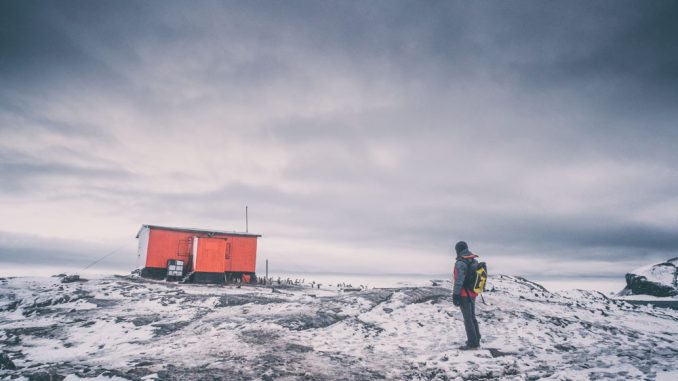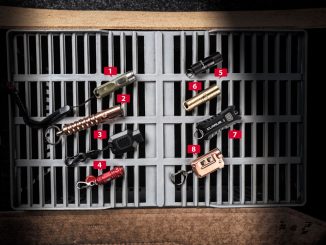
Nothing is quite like the feeling you get when you know you are safe and secure as the world around you is in seemingly utter chaos. Like a baby in its mother’s womb, the sense of comfort that shelter gives us is engrained in our DNA. Shelter protects us from the wind, rain, sleet and snow, keeping us cool when it is hot and warm when it is cold. It hides us from our enemies, and it can protect us from the ravages of war.
While building a survival shelter may not be the “sexiest” survival skill there is, it is certainly one of the most vital. Gaining the knowledge to find or fabricate shelter when faced with an emergency can truly be the difference between making it through alive and becoming just another statistic.
There are as many shelter options as there are survival situations and locales, so here is a helpful way for you to prepare for securing a safe place—no matter what predicament you find yourself in. If you can master “PACERS” (Primary, Alternative, Contingency, Emergency, Retreat, Societal), you’ll be ready for virtually any shelter challenge.
1.0 PRIMARY SHELTER
This is your home of residence and the place you spend the majority of your time. Your primary shelter should be built to a standard and code and be capable of withstanding most local natural weather events, shy of hurricanes or tornado-force winds and major flood events. It should have a temperature- and humidity-controlled environment in which the space can be effectively ventilated, heated or cooled sufficiently to promote good health and reasonable comfort.
1.1 Basic Provisions
Have enough medical and emergency supplies to be able to sustain each planned resident for 15 to 30 days. This should include a stock of 3,000 to 5,000 calories and 2 gallons of water per person per day. The volume of supplies might need to be greater, depending on how far you live from lines of communication and improved roads and highways.
1.2 Examples of Primary Shelters
1.2.1 House
1.2.2 Apartment, condominium or townhouse
1.2.3 Installed mobile home
2.0 ALTERNATIVE SHELTER
In the event of an emergency situation requiring evacuation from your primary shelter, this would be your closest, fastest and safest shelter alternative that ideally does not require you to travel more than 15 minutes by foot to get to. The key point to understand about an alternative shelter is that it is only a temporary location designed to protect you structurally from the initial effects of a catastrophic event. These shelters should be self-sustaining for up to 72 hours, and they should provide significantly better protection than you would be provided if you were to remain in your primary shelter.
2.1 Examples of Alternative Shelters
2.1.1 Safe room
2.1.2 Storm shelter
2.1.3 Home bunker/fallout shelter
2.1.4 Community safe spaces (hospitals, banks, libraries, post offices, schools, malls and hotels)
2.1.5 Churches, temples, mosques and other religious centers
2.1.6 National Guard armories and military bases
3.0 CONTINGENCY SHELTER
Contingency shelters are generally transient in nature. Because they are methods of transportation, you would normally use them as a temporary form of “portable” shelter. Their primary role is to get you to a safer and more secure location.
3.1 Examples of Contingency Shelters
3.1.1 Waterborne vessels
3.1.2 Recreational vehicles and campers
3.1.3 Motorized and nonmotorized vehicles
4.0 EMERGENCY SHELTER

A debris hut is one of the simplest survival shelters to construct. In addition, it requires the least amount of manmade materials.
Emergency shelters can be either man-made or natural in construction. These shelters can be individually constructed, or they might be provided by local, state or federal agencies or nongovernmental organizations (NGO) that provide aid to displaced people after catastrophic events.
The key word that characterizes this type of shelter is “emergency,” meaning that this is a shelter you would only use if the previous three types weren’t available or appropriate. You would use these shelters in an emergency, such as when you need basic protection from the elements or for concealment from observation by those who have the potential to do you harm.
4.1 Examples of Emergency Shelters
4.1.1 Poncho hooch/tarp
4.1.2 Tent
4.1.3 Prefabricated emergency shelter
4.1.4 FEMA or American Red Cross trailer
4.1.5 Bushcraft and natural survival shelter (debris hut, swamp bed, lean-to, cave, rock overhang, etc.)
4.1.6 Shipping container
4.1.7 Abandoned building or related structure
4.1.8 Abandoned train, subway car, bus, watercraft or aircraft
4.1.9 Barn, feed silo and other outbuildings
4.1.10 Sewer system and tunnels
5.0 RETREAT SHELTER

A snow cave makes an excellent winter shelter and can increase your odds of survival significantly. It is particularly important to ensure good ventilation when utilizing a snow shelter.
Your retreat shelter is essentially your bug-out location. This is where you have predetermined to go in the event something happens that is so catastrophic that return to your home in the foreseeable future is between unlikely and impossible. The key to a successful retreat or bug-out shelter is advance planning. You can find a plethora of information on the Internet and in books and survival magazines related to bug-out bags (BOBs) or just to bugging out in general, but it is harder to find information about where you are supposed to go when you bug out.
5.1 Reciprocal Agreements
One other quite similar, but suitably different, location would be an ally’s “bug-in” shelter. ”Bug-in” is a term used by those whose survival plan is, at least initially, to hunker down in their primary shelter in the event of a catastrophe. This is a perfectly sound option, just as long as ground zero of the event is not so close to your friend’s location that it makes getting, or staying, there impossible.
This is one aspect of what I mean when I suggest that everyone should have a “plan B.” By coordinating with another likeminded prepper who lives far enough away but close enough to get to, you can increase your probability for success, as well as your comfort and confidence levels.

Finding a retreat location that is secluded and hard to reach will increase your survivability by making it a more unlikely target for marauders and bandits.
5.2 Anonymity
The wise Benjamin Franklin observation, “Three may keep a secret if two of them are dead,” rings true when it comes to your bug-out location. Your plans were made to accommodate a limited number of people, so advertising this location to the world will probably come back to haunt you if you have to use it. When you’re dedicating all your efforts to taking care of your group, one of the most destructive things that can happen is to have some of the people you told about your plans show up at your bug-out location—and that’s assuming you get there before they do.

Abandoned buildings can make suitable temporary shelter hole-up sites as you work your way away from population centers out into the countryside— and hopefully to a pre-planned location.
5.3 Security
The types and difficulty of security preparations will be determined by a number of variables, particularly the layout of your retreat, its terrain and proximity to other people.
THE KEY POINT TO UNDERSTAND ABOUT AN ALTERNATIVE SHELTER IS THAT IT IS ONLY A TEMPORARY LOCATION DESIGNED TO PROTECT YOU STRUCTURALLY FROM THE INITIAL EFFECTS OF A CATASTROPHIC EVENT.
5.3.1 It should go without saying that you should have ample amounts of assorted weapons and ammunition, as well as the knowledge to employ them if needed. (Do you have the ability to interlock or cross over fields of fire in order to create a 360-degree security ring around your shelter?)

Getting to know and rely on your neighbors will provide you with a valuable outer security ring and early-warning system.
5.3.2 How well can you see all avenues of approach to your location? What level of cover or protection does your retreat shelter provide from both direct and indirect fire? How well-hidden is it from being detected and observed by others?
5.3.3 Do you have both inner security rings (fences around your shelter or property), as well as the more-important and often-ignored outer security rings? The latter is created by the relationships you form with neighbors and land owners who surround your retreat shelter. They can provide you with both early warning and support in the event you have to defend your shelter from aggressive intruders.

The Louisiana Superdome in New Orleans, Louisiana, was used as an emergency shelter during Hurricane Katrina in 2005.

You never know what might cause your planned route to one of your contingent shelter locations to be thwarted—such as the washed-out road here—so you should always plan an alternative route.
5.4 Capacity
Make certain the location you choose for bugging out is capable of supporting not only you and your family or group, but others as well. In the event that necessity or happenstance increases the size of your bug-out party—before or after getting to your bug-out location—having a bit more space and supplies than what you need might enable you to add useful members to your group.
5.5 Pre-Stocked Supplies
Your retreat should be pre-stocked with food, water, medical and other emergency stores to provide you with everything needed to sustain yourself and your family for a prolonged period of time. The exact amount of food, water and supplies you keep is really only limited by your storage space and your wallet. A good rule of thumb for a long-term stay in a retreat is to have six months’ worth of extended-shelf-life food for your party, as well as a replenishing water source and the means to purify water on site. When determining food and water requirements, don’t skimp. One gallon of water and 1,500 calories per day might qualify as subsistence, but it’s not enough to keep you healthy in an active and stressful environment.

A home lies in ruins in the aftermath of a tornado near a completely intact and undamaged storm shelter in the foreground.

Don’t forget to consider your pets when seeking shelter in times of emergency. Like small children, pets depend on humans for their safety, so take responsibility— instead of leaving your pets to fend for themselves—while you look for shelter and safety.
5.6 Sustainable Location
If buying a location for your retreat is an option or necessity, look for areas that have ample natural resources to replenish your stores and sustain you and your party for the foreseeable future. At a minimum, you should find property with access to a year-round natural water source, abundant hunting grounds for small and large game and fertile soil for planting future food stocks.
SOCIETAL SHELTERS ARE NORMALLY SHARED BY PEOPLE WHO BRING TO THE TABLE VARIED SKILLS, ABILITIES AND EXPERIENCE THAT MAKE THEM UNIQUELY QUALIFIED TO CONTRIBUTE SIGNIFICANTLY TO THE LARGER GROUP.
5.7 Distance
When I refer to “distance,” I am talking about both the distance from your primary shelter to your retreat shelter, as well as the distance of your retreat shelter from large population centers.
The exact distance you want to be from “ground zero” will vary depending on what type of event you are bugging out from. The bottom line is that the farther you are from major population centers and highways, the fewer the chances are that you will need to fight off desperate bands of thugs and marauders. That said, be sure to balance this distance with the time and risk that might be associated with traveling from your primary shelter to your retreat shelter.

It is important to be decisive and quick about leaving a high-population area and seeking shelter elsewhere, because riots and martial law are sure to follow. Once that happens, it could become next to impossible to leave.
5.8 Communication
Stay informed about what is happening locally and in the larger world around you. A shortwave or HAM radio, protected from electromagnetic pulse (EMP) by a Faraday cage, can keep you abreast of the situation that caused you to bug out to your retreat shelter in the first place.
You should also consider having other communications devices and gear on hand, such as FRS or GMRS two-way radios, scanners, CB radios, repeaters, antennas, power sources and weather radios, as well as low-tech signal devices. There are options to fit most budgets and situations that can help you monitor the situation and communicate with the outside world.
6.0 SOCIETAL SHELTER
I am a firm believer in self-reliance. I am fairly proficient at the relevant skills and knowledge, and I have supplies needed to provide for myself and my family. Even so, I am aware that I have limitations. For those who are less prepared—for any number of reasons—a societal shelter might be an appealing option. Societal shelters are normally shared by people who bring to the table varied skills, abilities and experience that make them uniquely qualified to contribute significantly to the larger group. Bear in mind that, like preppers, no two societal shelters will be alike.
HAVE ENOUGH MEDICAL AND EMERGENCY SUPPLIES TO BE ABLE TO SUSTAIN EACH PLANNED RESIDENT FOR 15 TO 30 DAYS. THIS SHOULD INCLUDE A STOCK OF 3,000 TO 5,000 CALORIES AND 2 GALLONS OF WATER PER PERSON PER DAY.
6.1 Filling the Gap
Societal shelters are more than simple physical structures, because they tend to be more conceptual in nature. The idea of a societal shelter is that in the event of a catastrophe, as a result of which the layers of government cease to function, these micro-communities provide some of the basic organization and support the defunct government entities once did. This lapse can be temporary, such as during the response to a major calamity, or longer term, as in the case that the current government is decimated and will take many months or years for it to return to governance.

You can expect local schools to open as emergency shelters in the aftermath of an emergency scenario, as a result of which people need safe shelter.
These smaller micro-communities are made up of people who come together by choice or by chance. And they have, regardless of personal views, opinions or beliefs, committed themselves to conform to the basic human norms that allow people to live together in harmony. Simply stated, that’s a commitment and individual contribution and service to the group, along with a respect for individuals’ liberties and property.
Additionally, it might become necessary for these societal groups to form militias to defend themselves and their resources. These militias, while not conventional military forces, could be called upon at some point to help reestablish the local, state and federal governments and to fight against their common enemies, both foreign and domestic. These new micro-communities should be prepared to support, and eventually reunite with, the legitimate and officially elected government when it begins the reunification process.

While FEMA and the American Red Cross might set up tent cities after a crisis displaces people, these are not always the best places to be. Often, they become disease- and crime-ridden as they fill beyond capacity and security and aid workers are unable to handle the number of people in need.
6.2 Common Factors
6.2.1 All members are willing to comply with a rudimentary constitution (at minimum) that promotes basic human norms or laws.
6.2.2 They have the resources needed to be self-sustaining and don’t require resupply from the outside for essential logistical stores in order to survive.
6.2.3 They have an agreed-upon leadership structure and system that allow for individuals to take on key rolls of governance and responsibility through either appointment by an elected official or through individual elections.
6.2.4 In order for a community to be a true societal shelter, all its members should be willing to swear their allegiance to protect and defend the new “constitution” up until the time that the U.S. government and Constitution resume functioning.
Editor’s note: A version of this article first appeared in the Prepper Fall, 2018 print issue of American Survival Guide.





Be the first to comment